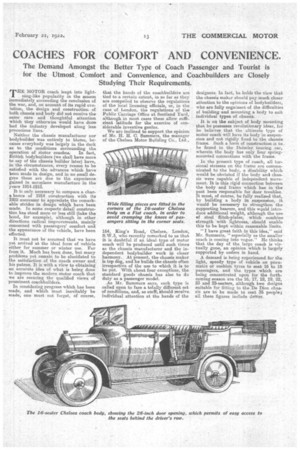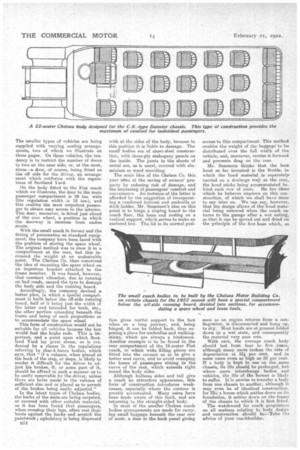COACHES FOR COMFORT AND CONVENIENCE.
Page 13

Page 14

If you've noticed an error in this article please click here to report it so we can fix it.
The Demand Amongst the Better Type of Coach Passenger and Tourist is for the Utmost, Comfort and Convenience, and Coachbuilders are Closely Studying Their Requirements.
THE MOTOR coach leapt into lightning-like popularity in the season immediately succeeding the conclusion of the war, and, on account of its rapid evolution, the design and construction of both chassis and body did not receive the same care and thoughtful attention which they otherwise would have done had the industry developed along less precocious lines.
Neither the chassis manufacturer nor bodybuilder was entirely to blame, because everybody was largely in the dark as to the conditions surrounding the operation of motor coaehes. In fact, British bodybuilders (we shall have more to say of the chassis builder later) have, in the circumstances, every reason to be satisfied with the advances which have been made M design, and in no small degree these are due to the experience gained in aeroplane manufacture in the years 1914-1918.
It in only necessary to compare a chara banes of 1914 construntion with its 1922 successor to appreciate the remarkable strides in design which have been made. In some respecte•daail construction has stood more or less still (take the hood, for example), although in other directions radical improvements, mainly concerned with passengers' comfort and the appearance of the vehicle, have been effected.
It must not be assumed that we have yet arrived at the ideal form of vehicle either for summer or winter use. Far from it. Much has been done, but many problems yet remain to be elucidated to the satisfaction of the coach owner and his patron. It is with a view to obtaining an accurate idea of what is being done to improve the modern motor coach that we are securing the qualified views of prominent coachbuilders.
In eerisidering progress which has been made, and which must inevitably be made, one must not forget, of course, that the hands of the coachbuilders are tied to a certain extent, in so far as they are compelled to observe the regulations of the local licensing officials, or, in the case of London, the regulations of the Public Carriage Office at Scotland Yard,' although in most cases these allow sufficient latitude for the exercise of considerable inventive genius. We ars inclined to support the opinion. of Mr. H. H. C. Sommers, the manager of the Chelsea Motor Building Co., Ltd., 164, King's Road, Chelsea, London, S.W.3, who recently remarked to us that it is doubtful if an ideal_ type of motor coach will be produced until such times as the chassis manufacturer and the independent bodybuilder work in closer harmony. At present, the chassis maker is top dog, and he builds the chassis often irrespective of the use to which it is to be put. With about four exceptions, the standard goods chassis has also to do duty as a passenger model. As Mr. Summers says, each type is called upon to face a totally different set of conditions, and, as sue?t, should receive individual attention at the hands of the designers. In fact, he holds the view that . the chassis maker should pay much closer attention to the opinions of bodybuilders, who are fully cognizant of the difficulties of building and mounting a body to suit individual types of chassis.
It is On the subject of body mounting that he possesses revolutionary ideas, for he believes that ths ultimate type of motor coach will have its body in suspension and not rigidly fixed to the chassis frame. Such a form of construction is to be found in the Daimler touring car, wherein the body has only four springmounted connections with the frame.
In the present type of coach, all torsional stresses on tho frame are communicated to the body, a disability which would be obviated if the body and chassis were capable of independent movement. It is this rigid connection between the body and frame which has in the past been responsible for door troubles. It must, of course, be fully realized that, by building a body in suspension, it weulcl be necessary to strengthen the supporting bearers, and this weuld introduce additional weight, although the use of steel flitch-plates, which combine strength with lightness, should enable this to be kept within reasonable limits.
"I have great faith in this idea," said Mr. Summers, "especially as the smaller coach is coming into vogue." He thinks that the day of the large coach is virtually gone, an opinion which is largely supported by orders in hand.
A demand is being experienced for the light, speedy type of vehicle on pneumatie or cushion tyres to seat 16 to 18 passengers, and the types which are being concentrated upon for the forthcomingseason are the 16, 17, 18, 19, 22, 23 and 25-seaters, although two designs suitable for fitting to the De Dion chassis are to be made to seat 35 people; all these figures include driver. The 'smaller types of vehicles are being supplied with varying seating arrangements, two of which we illustrate on these pages. On these vehicles, the tendency is to restrict, the number of doors to two On the near aide, or, at the most, three—a door, of course, being fitted on the off side for the driver, an arrangement which conforms with the regulations of Scotland Yard.
On the body fitted to the Fiat coach which we illustrate, the door to the main passenger compartment is 28 ins. wide (the regulation width -is 18 ins.), and this enables the most corpulent passenger to obtain easy access to the interior. This door, moreover, is fitted just ahead of the rear wheel, a position in which the doorway is immune from undue strain,
With the small coach in favour and the fitting of pneumatics as standard equipment, the company have been faced with the problem of storing the spare wheel. The original method was to stow it in a compartment at the rear, but this increased the weight at an undesirable point. The Chelsea Co. then conceived the idea of mounting the spare wheel on on ingenious bracket attached to the frame member. It was found, however, that constant vibration, due to running on bad roads, caused the tyre to damage the body side and the running board. Accordingly, the company: devised a better plan, in which a special compartment is built below the off-side running board, half of it being just the width of the latter and intended for tools, etc., the other portion extending beneath the frame and being of such proportions as to accommodate the spare wheel. This form of construction would not be suitable for all vehicles because the box would foul the brake rods. This is important, and a point upon which Scotland Yard lay great stress, as is evidenced by a clause in the regulations referring to char-a-bancs bodies, which says, that "if a valance, when placed at the back of the step, or steps, is likely to render it difficult for the driver to adjust his brakes, it, or some part of it, should be affixed in such a manner as to he easily removable by the driver, unless there are holes made in the valance of sufficient size and E.0 placed as to permit of the brakes being easily adjusted."
In the latest types of Chelsea bodies, the backs of the seats are being carpeted, or covered with other suitable material, as it has been found that passengers, when crossing their legs, often rest their boots against the backs and scratch the paintwork; upholstery is being dispensed n14 with at the sides of the body, because in this position it is liable to damage. The small bodies are of sheet-steel construction, with three-ply mahogany panels on the inside. The joints in the sheets of metal are, as is usual, covered with aluminium or wood moulding.
The main idea of the Chelsea Co. this year -aims at the saving of owners' property by reducing risk of damage, and the increasing of passengers' comfort and convenience. An instance of the latter is afforded by the suggestion of incorporating a combined footrest and umbrella or stick holder. Mr. Stiminers's idea on this point is to hinge a eloping board to the coach floor, the low, end resting on a vertical support, which serves to make an enclosed box. The lid in its normal posi
tion gives restful support to the feet -when on a long journey, and, being hinged, it can be folded back, thus exposing a place for umbrellas and walkingsticks, which are always a hindrance. Another example is to be found in the year compartment of the 16-seater Fiat coach, in which wide filling pieces are fitted into the corners so as to give a better seat curve, and to avoid cramping the knees of passengers sitting in the curve of the seat, which extends right round the body sides.
Although bulbous sides and tail give a coach an attractive appearance, this form of construction introduces weaknesses, especially where the contour is greatly accentuated. Many users have been made aware of this fault, and are returning to the straight-sided body.
In most of the smaller Chelsea coach bodies arrangements are made for carrying small baggage beneath the rear row of seats a door in the back panel giving
access to this compartment. This method enables the weight of the baggage to be distributed over the full width of the vehicle, and, moreover, carries it forward and prevents drag on the rear.
Mr. Summers thinks that the hest hood so far invented is the Bartle, in which the hood material, is separately. carried on a drainage tray at the rear, the hood sticks being accommodated behind each row of seats. fle has ideas which he believes improve on this construction, of which we shall have more to say later on. We can say, however, that the design allows of the hood material being removed when the coach returns to the garage after a wet outing, so that it can be spread out and dried on the principle of the finn hose which, so
soon. as an engine returns from a con. flagration, is disconnected and hung up, to dry. l'elost hoods are at present folded down in a wet state, and consequently the material very soon rots.
With care, the average coach body should last from four to five 'ears,althoughmany users reckon the rate of depreciation at 34 per oent, and in some cases even As high as 50 per cent. If a body is kept in use on the same chassis, its life should be prolonged, but where users interchange bodies and vehicles, the life of the former is likely to suffer, It is unwise to transfer a body from one chassis to another, although it May even be of identical construction, for like a house which settles down on-its foundation, it settles down on the frame of the chassis to which it is first fitted.
The watchword fur coach proprietors on all matters relating to body design and construction ahould be—Take the advice of irony coachbuilder.






























